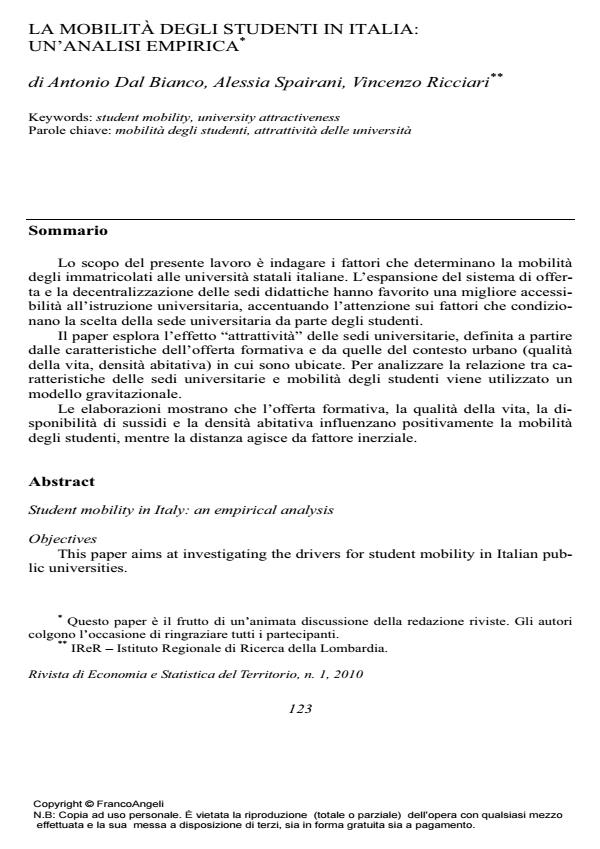La mobilità degli studenti in Italia: un 'analisi empirica
Journal title RIVISTA DI ECONOMIA E STATISTICA DEL TERRITORIO
Author/s Antonio Dal Bianco, Alessia Spairani, Vincenzo Ricciari
Publishing Year 2010 Issue 2010/1 Language Italian
Pages 21 P. 123-143 File size 325 KB
DOI 10.3280/REST2010-001005
DOI is like a bar code for intellectual property: to have more infomation
click here
Below, you can see the article first page
If you want to buy this article in PDF format, you can do it, following the instructions to buy download credits

FrancoAngeli is member of Publishers International Linking Association, Inc (PILA), a not-for-profit association which run the CrossRef service enabling links to and from online scholarly content.
Student mobility in Italy: an empirical analysis The growing number of universities and the decentralization of their locations in recent years have increased the possibility of more students entering the university system; it is therefore important to understand the reasons why students choose their university. Methods and Results This paper defines the attractiveness of universities using several key factors, such as the supply of academic courses in different subjects, their organization and quality. It also considers external factors related to the urban context in which universities are located (i.e. quality of life, population density). In order to analyze the statistical relationship between academic locations and student mobility, this paper uses a gravitational model. The results show that selected factors - such as the amount and type of courses, the availability of student loans and grants, and the high population density - have a positive impact on student mobility, attracting a larger number of students, while the distance from their native city acts as a frictional factor. Conclusions Many of the factors that influence student mobility are not under the control of university management. It is therefore even more important for regional governments to start an assessment process, that would allow students to make more informed choices, and to develop policies for accommodations and student loans and grants, in order to decrease the gap between national and local universities, thus avoiding a narrower selection of students (poorer and/or less motivated) towards these latter structures. Objectives This paper aims at investigating the drivers for student mobility in Italian public universities.
Jel codes: I210, J240, J600, O150, R230
- Studies in Theoretical and Applied Statistics Marco Enea, pp.239 (ISBN:978-3-319-73905-2)
- A new measure for the attitude to mobility of Italian students and graduates: a topological data analysis approach Martina Vittorietti, Ornella Giambalvo, Vincenzo Giuseppe Genova, Fabio Aiello, in Statistical Methods & Applications /2023 pp.509
DOI: 10.1007/s10260-022-00666-x - Going the distance: The effects of university – secondary school collaboration on student migration Jörg Raab, Joris Knoben, Ludmilla Aufurth, Bram Kaashoek, in Papers in Regional Science /2018 pp.1131
DOI: 10.1111/pirs.12288 - La mobilità per ragioni di studio dei diplomati meridionali Amedeo Di Maio, Giuseppe Lucio Gaeta, in QA Rivista dell'Associazione Rossi-Doria 3/2013 pp.81
DOI: 10.3280/QU2013-003003 - Student mobility in Italy: The increasing role of family background during the expansion of higher education supply Roberto Impicciatore, Francesca Tosi, in Research in Social Stratification and Mobility 100409/2019 pp.100409
DOI: 10.1016/j.rssm.2019.100409 - Computational Science and Its Applications – ICCSA 2018 Massimo Iaquinta, Paola Perchinunno, Francesco Rotondo, pp.651 (ISBN:978-3-319-95161-4)
Antonio Dal Bianco, Alessia Spairani, Vincenzo Ricciari, La mobilità degli studenti in Italia: un 'analisi empirica in "RIVISTA DI ECONOMIA E STATISTICA DEL TERRITORIO" 1/2010, pp 123-143, DOI: 10.3280/REST2010-001005